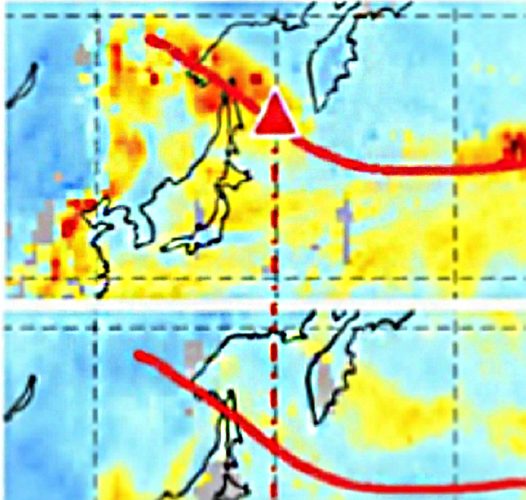
Détection de méthane par LIDAR RAMAN : LILAS
Le laboratoire LOA poursuit son activité de développement instrumental du LIDAR RAMAN LILAS, instrument unique à Lille financé en partie par le Labex CaPPA.
Igor Veselovskii, professeur invité régulier du Labex CaPPA, Philippe Goloub, professeur au LOA, Qiaoyun HU, doctorante au LOA et Thierry Podvin, ingénieur au LOA, ont étudié le profil du méthane dans l’atmosphère lillois en mai-juin 2018.
Le voie vapeur d’eau du LIDAR RAMAN LILAS a été remplacée, le temps de l’expérience, par une voie de détection méthane.
Les résultats de ces travaux ont été soumis pour publication au journal AMT.
Veselovskii, I., P. Goloub, Q. Hu, T. Podvin, D.N. Whiteman, M. Korenskiy, E. Landulfo, Profiling CH4 background mixing ratio with Raman lidar technique in the lower troposphere: a feasibility experiment (submitted to Atmos. Meas. Tech, 2018). https://www.atmos-meas-tech-discuss.net/amt-2018-298/
Ce travail est présenté dans le rapport ci-après.
Methane profiling over Lille from LILAS Raman lidar
Veselovskii, I., P. Goloub, Q. Hu, T. Podvin et al.,
September 2018
Methane is currently the second most important greenhouse gas. Methane is emitted from a variety of natural and anthropogenic sources and on a per-molecule base, methane is about 30 times more effective greenhouse gas than carbon dioxide. Today, it is well established that, in the free troposphere region, the CH4 mixing ratio is about 2 ppm, while inside the planetary boundary layer, the mixing ratio can be significantly increased in the vicinity of methane sources.
Raman spectroscopy is a powerful technique for identification of different atmospheric gases and for the estimation of their concentration, which can be used in conjunction with lidar technology. During Spring 2018, LOA performed a dedicated experiment to measure background CH4 profiles in the lower troposphere using LILAS Raman lidar from Lille University observatory platform (Hauts-de-France region, France). For evaluating CH4, LILAS Mie-Raman lidar was modified: the water vapor Raman channel was replaced by the methane one. This has been done in cooperation with Pr. I. Veselovskii (regular invited professor, Labex CaPPA) from the Russian academy of science, Moscow. Measurements were performed during May-June, 2018, with in total, 20 nighttime observation sessions. The analysis of this experiment is summarized in the paper of Veselovskii et al., submitted to AMT. Results demonstrate that, inside the planetary boundary layer, CH4 mixing ratio may exceed the background concentration levels by up to a factor of 2. Enhancement of the CH4 mixing ratio in weak elevated aerosol layers was also detected. During this campaign, we detected elevated CH4 layer, ranging between 3000 and 5000 m (figure 1).

To understand the origin of this elevated layer, a ten-days back-trajectory analysis has been performed (figure 2). The propagation of the air mass is clearly coincident with the transport of CO plumes. Hence, it is very likely that the observed methane plume comes from fire emissions in eastern Asia. Aged smoke particles mixed with Asian dust particles could be the reason for the high particle depolarization ratio observed in the elevated layer.
Figure 1: Profiles of CH4 mixing ratio and aerosol properties (backscattering coefficient β532 together with particle depolarization ratio δ532) obtained during the night 13-14 June 2018 over Lille (accumulation time is 4 hours).

Figure 2: Ten-day backward trajectories for the air mass in Lille at altitude 4000 m on 14 June 2018 at 00:00 UTC. Figure (a)-(b) plot the trajectory pathway overlaid with CO columnar concentration maps retrieved from AIRS data. The triangles represent the location of the traced air mass on corresponding dates. Figures (c) and (d) show the trajectory and vertical propagation with time ticks.
Raman measurements of CH4 mixing ratio on a level of 2 ppm is a challenging task and different potential interfering factors, were analyzed. The measurements inside the clouds revealed no interfering with elastic signal, however we can not completely exclude the possibility of a fluorescence contribution. In future measurements we plan to introduce an additional control channel close to 393 nm where no strong Raman lines exist and only fluorescence can be detected.
References:
Veselovskii, I., P. Goloub, Q. Hu, T. Podvin, D.N. Whiteman, M. Korenskiy, E. Landulfo, Profiling CH4 background mixing ratio with Raman lidar technique in the lower troposphere: a feasibility experiment (submitted to Atmos. Meas. Tech, 2018).
Veselovskii, I., Goloub, P., Podvin, T., Tanré, D., da Silva, A., Colarco, P., Castellanos, P., Korenskiy, M., Hu, Q., Whiteman, D. N., Pérez-Ramírez, D., Augustin, P., Fourmentin, M. & Kolgotin, Characterization of smoke and dust episode over West Africa: comparison of MERRA-2 modeling with multiwavelength Mie–Raman lidar observations. Atmos. Meas. Tech., 11(2), 949-969. 10.5194/amt-11-949-2018
Veselovskii, I., Goloub, P., Podvin, T., Tanré, D., Ansmann, A., Korenskiy, M., Borovoi, A., Hu, Q. & Whiteman, D. N. (2017). Spectral dependence of backscattering coefficient of mixed phase clouds over West Africa measured with two-wavelength Raman polarization lidar: Features attributed to ice-crystals corner reflection. J. of Q. Spec. Rad. Trans., 202, 74-80. 10.1016/j.jqsrt.2017.07.028
Bovchaliuk, V., Goloub, P., Podvin, T., Veselovskii, I., Tanré, D., Chaikovsky, A., Dubovik, O., Mortier, A., Lopatin, A., Korenskiy, M. & Victori, S. (2016). Comparison of aerosol properties retrieved using GARRLiC, LIRIC, and Raman algorithms applied to multi-wavelength lidar and sun/sky-photometer data. Atmos. Meas. Tech., 9(7), 3391-3405. 10.5194/amt-9-3391-2016
Veselovskii, I., Goloub, P., Podvin, T., Bovchaliuk, V., Derimian, Y., Augustin, P., Fourmentin, M., Tanré, D., Korenskiy, M., Whiteman, D. N., Diallo, A., Ndiaye, T., Kolgotin, A. & Dubovik, O. (2016). Retrieval of optical and physical properties of African dust from multiwavelength Raman lidar measurements during the SHADOW campaign in Senegal. Atmos. Chem. Phys., 16(11), 7013-7028. 10.5194/acp-16-7013-2016.


